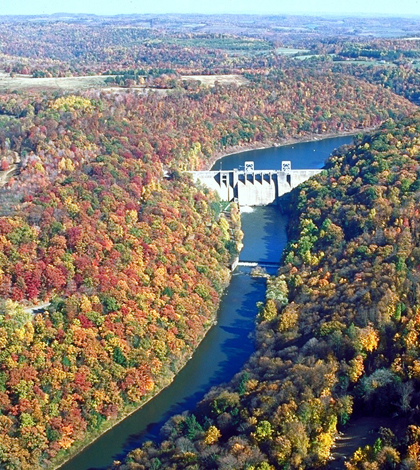70 years after construction, hydropower coming to Mahoning Creek Dam

Mahoning Creek Dam and Lake (Credit: U.S. Army Corps of Engineers)
In 1938, as part of an effort to develop flood controls in the Allegheny River basin in Western Pennsylvania, the U.S. Army Corps of Engineers broke ground on the Mahoning Creek Dam. By 1941, the project was complete.
Although initial plans to equip the dam for hydropower were scrapped due to steel shortages associated with the nation’s accelerating war mobilization efforts, project engineers included a hydropower conduit in the final design so the dam could later be retrofitted for energy production.
Seven decades later, Enduring Hydro, LLC, a Maryland-based hydropower developer is implementing the vision of those early engineers. In partnership with the U.S. Army Corps of Engineers Pittsburgh District, the company is constructing a 6-megawatt, environmentally responsible hydroelectric facility on the Mahoning Creek Dam.
The project is scheduled to come online in late 2013. Enduring Hydro expects that the facility will generate 20,000 megawatt-hours of clean, carbon-free electricity annually for the next 50 to 100 years. That is enough electricity to power 1,800 homes, and is equivalent to planting 1,000,000 trees as it replaces 10,000 tons of carbon dioxide from fossil fuel electricity.
“There are over 75,000 unpowered dams in the United States,” said Kristina Johnson, Enduring Hydro’s founder and CEO. “We think Mahoning Creek is a perfect example of the common-sense energy solutions our country needs in order to build a clean and vibrant 21st century economy.”

Work begins on the Mahoning Creek powerhouse. (Credit: Mike Voellmecke)
To succeed, the project must accommodate the interests of a variety of stakeholders. “One of our goals going into this was to figure out how to produce the maximum amount of energy possible, while not negatively impacting the natural resource we are utilizing,” said David Fox, the project’s environmental manager.
Once the project is up and running, water from the upstream reservoir will flow into a 10-foot diameter steel conduit, travel 1,000 feet downstream and enter a powerhouse containing two specially designed hydropower turbines. The reservoir stratifies in the summer, and the deeper zone can have fairly low oxygen levels. “If we are not careful, this oxygen depleted water could negatively affect conditions downstream of the hydropower facility,” Fox said.
To mitigate this risk, Enduring Hydro, in coordination with the Army Corps and the Pennsylvania Department of Environmental Protection, has studied the system and evaluated how the project could impact water quality. Based on this work, Enduring Hydro and the Army Corps collaboratively developed an Adaptive Management Plan which specifies how the facility will be operated.
To implement this plan, a network of NexSens data loggers and YSI water quality sensors will monitor water quality at the reservoir intake, in the stilling basin just downstream of the dam, and at the hydropower outfall. The data will be posted on a website in real time, and will also feed directly into the power plant control system.

NexSens Data Logger deployed on Mahoning Creek Dam (Credit: Mike Voellmecke)
The entire system will be automated. If water quality standards drop below agreed upon levels, the control system will reduce flow to the powerhouse, and oxygen rich water flowing through a bypass valve at the dam will be increased. “We are confident this solution will enable us to maintain the environmental integrity of Mahoning Creek while meeting our energy generation goals,” Fox said.
Top image: Mahoning Creek Dam and Lake (Credit: U.S. Army Corps of Engineers)





0 comments